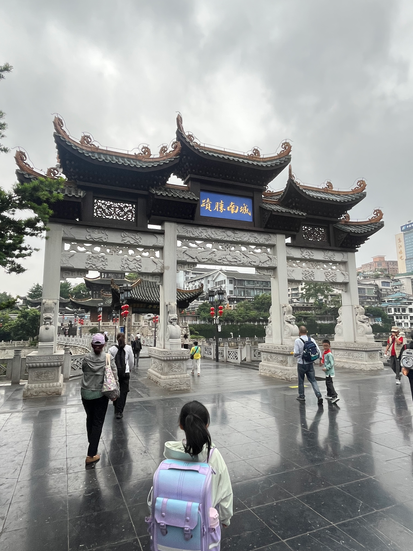City Observer – Guiyang From a Remote Mountainous Province to China’s New Economic and Tourism Darling
- gracemu1020
- Jun 9
- 4 min read
As a Chongqing native, born and raised near the border with Guizhou Province, I was never particularly impressed by this mountainous region adjacent to Chongqing and Sichuan. Just after graduating, I once traveled to a remote but stunning riverside village in Guizhou for rafting. It was deep in the mountains, and I remember being struck by both the beauty and the poverty — the villagers could barely afford salt in the early 2000s. The trip left me with mixed feelings: I had the time of my life rafting in the most crystal clear river I’d ever seen, yet I was deeply unsettled by the hours of isolation on a single minivan winding through pitch-dark mountains with no end in sight. Urban legends of young women being abducted in such impoverished regions only intensified my unease. It felt like the perfect setting for a Stephen King horror story. I didn’t return to Guizhou for the next 20 years.
But that past now feels very distant. In the last two decades, Guizhou has transformed dramatically — from one of China’s most underdeveloped provinces into the nation’s Big Data Valley, boosted by national policy and the high-tech boom. According to 2024 government statistics, Guiyang, the capital of Guizhou, has even surpassed Shenzhen to become the city with the fastest-growing population in China.
A recent article from Jingzhi Chronicle on Guizhou’s booming matcha plantations rekindled my curiosity about this “sleeping beauty.” A quick search on RedNote returned over 747,000 posts about travel in Guizhou. The new Guizhou has many things to be proud of — coffee, matcha, Big Data… far beyond its previous fame as the home of China’s most iconic luxury liquor, Moutai.
Last week, I flew from Shanghai to Guiyang and explored two starkly different sides of the city: its historic core and its emerging contemporary face.
A City of Two Faces
A Yun Duo Cang(阿云朵仓), meaning “our ideal place” in the local Yi dialect, is currently one of the trendiest destinations in Guiyang’s new district, buzzing with Gen Z energy. It’s part of a new wave of mixed-use urban developments combining hotels, retail, art exhibitions, theaters, and communal cultural spaces. A skatepark sits at the center, where the city’s coolest youth perform tricks in full gear. I sipped my coffee at Dui De(对的), one of the most stylish cafés in town, with prices on par with those in Shanghai, while watching skaters strike bold poses.
As I strolled through boutique shops selling everything from fragrances to art toys, I was drawn to an impressionist oil painting labeled “Gallery.” To my surprise, it turned out to be the entrance to a designer hotel — Pearl Gallery — hidden among lush greenery. Inside, the interior was beautifully curated, and the staff proudly explained how the hotel design drew inspiration from local architectural heritage and minority culture, aiming to promote and preserve Guizhou’s cultural legacy. This reminded me of similar developments in more established cities, such as OōEli Art Park in Hangzhou. Guiyang, it seems, is catching up fast with newly acquired confidence and ambition.
Old Guiyang: A Window to the Past
The next day, I visited historic Guiyang in the Nanming District. Starting with a typical local breakfast of beef noodles(牛肉粉), I wandered through the old town, zigzagging past residential lanes and bustling wet markets. It brought back memories of my childhood in the 1980s and 90s. The urban planning felt dated, with awkward barricades cutting off pedestrian paths, but there was an authenticity here that I found moving.
If you’re tired of the overly curated and commercialized versions of “historic towns” found elsewhere, you’ll fall for old Guiyang. It’s like a piece of untouched land, rough but real, alive with local flavor. Even at well-known landmarks like Jiaxiu Pavilion and Wenchang Pavilion, there were hardly any tourists. On the old stone walls of Wenchang Pavilion, I saw a local man flying a kite alone, high up in the sky. In that moment, time seemed to pause. It was like stepping back into the 1990s, into a more innocent, hopeful China.
What Can Brands Learn from Guiyang’s Transformation?
As experience, cultural discovery, and lifestyle consumption become increasingly central across industries, particularly hospitality and tourism, here are a few takeaways from my trip:
1. Bring depth to localization
Brands must go beyond surface-level cultural references and tap into the emotional and sensory fabric of a place. Borrowing architectural patterns or symbols isn’t enough anymore. It’s often dull and repetitive. True cultural branding requires insight and empathy. In Guiyang, there’s a distinct “wild野” and “rough” energy — a laid-back “chillness” in the city’s DNA. Capturing and translating these intangible cultural qualities into your brand’s products, services, and storytelling could be what sets you apart.
2. Nostalgia is the new luxury
In times of economic uncertainty and social fatigue, nostalgia is resurging as a cultural force. Guiyang, with its slower pace and preserved authenticity, offers a glimpse into the past, and that feels comforting in today’s world.
China’s younger generation is embracing this nostalgia. They’re listening to ‘90s pop, celebrating past icons, and even collecting retro items like peel-apart instant film, now considered a nostalgic luxury. As Sixth Tone reported, this wave is driven by a desire for emotional predictability and cultural simplicity in contrast to current instability.
Brands should tune into this emotional undercurrent — nostalgia, sincerity, local character — and weave it into their positioning, content, and community building. After all, cultural branding is about sensing the mood of the times and creating resonant stories that meet people where they are.
Guiyang’s transformation from overlooked backwater to cultural powerhouse is not just a regional success story. It’s a case study in how places and brands can rediscover their soul, honor their roots, and boldly write a new narrative for the future.

















Comments